
Photo: Matthew Niederhauser
Shakespeare has been reinvented for the digital age with Hamlet 360: Thy Father’s Spirit, a modern film version of the play in the emerging technology of virtual reality. Directed by Steven Maler, the founding artistic director of Commonwealth Shakespeare Company, the hourlong film (available on the website of Boston public media station WGBH) had preliminary rehearsals at Babson’s Knight Auditorium. “This has never been done before,” says Maler. “This has been one of the most challenging and mind-bending projects I have ever worked on.”
]]>
Illustration: Oivind Hovland
Study abroad. That’s the number-one piece of advice I can give. I went on the Arcadia in Rome program, and while there, I also traveled to Lisbon, Paris, Berlin, Copenhagen, and many cities in Italy. Every city and country I visited, not only did I learn a new culture and perspective, but I also gained valuable insights into who I am as a student and person. In those three months, I learned more about myself than I have in my entire life. College is a fast-paced world, and I got caught up in doing too many things. Being abroad allowed me just to slow down, enjoy time alone, and truly appreciate what really matters. —My-Linh DeBonis ’19
Find people and environments where you can be yourself. For me that was Babson Dance Ensemble. I’ve danced my entire life, and it’s one of my greatest passions. The people I met through BDE are now some of my best friends and biggest inspirations, not only in terms of dance, but professionally and academically.
Also, take advantage of every opportunity that comes your way. Don’t be afraid to try new things. One of my favorite experiences at Babson was when I went on an elective abroad to Argentina and Uruguay during spring break. I didn’t know anyone going on the program, and I was very much out of my comfort zone. But I was able to make new friends and meet people whom I otherwise wouldn’t have. —Camille Jones ’19
A lot of times people come to Babson and say, I’ve got to get a 4.0 GPA. I got caught up in it, too. But it’s not worth the stress. I realized that college is more about the people you meet and the experiences you have. These things matter more. Your GPA only tells 10 percent of the story. There will always be someone with a higher GPA than you. Your experiences are what define you.
So value your time here, and focus on Babson holistically. Look for community, which sometimes can be difficult to find. Seek people with similar interests and bring them together. I was blessed to be a Posse Scholar, and I also took the initiative and headed the Muslim Student Association, helping to build it into a vibrant community. —Mahd Sharif ’19
My biggest tip for the incoming class: Get on Google Calendar and plan your life on it. The calendar helps me figure out my busy days and keeps me sane. My second tip is to make sure you’re passionate about everything you commit yourself to. My schedule is jam-packed, but I love everything I do.
Organizations like Habitat for Humanity, the admissions office , and my sorority, Chi Omega, are a few of the wonderful things that have made Babson feel like home to me. I also love attending performances by the Babson Dance Ensemble, the Rocket Pitches a cappella group, and the Students Against Gravity improv group. I even play on the women’s club ice hockey team. It makes me happy to take advantage of all the wonderful experiences that Babson offers. —Abi Cohen ’19
]]>For many Americans, doughnuts are a much-loved, feel-good food. More than 193 million people ate these hand-held treats in 2017, and a reported 10 billion doughnuts are made in the U.S. annually. Today, system-wide sales for Dunkin’ Brands—which includes Dunkin’ Donuts and ice cream maker Baskin-Robbins—exceed $11.1 billion from more than 20,000 locations worldwide. Dunkin’ Donuts itself is found in 46 countries.
In New England especially, Dunkin’ customers tend to be loyal and maintain a strong, emotional connection to the company, says Kate Jaspon ’98, CFO for Dunkin’ Brands. Jaspon, who joined the company as an assistant controller in 2006 after auditing it in her previous job with KPMG, remembers childhood visits with her family to Dunkin’ to pick up Munchkins. Professionally, she was drawn to the company because of its iconic branding and growth potential. As a Babson graduate and the daughter of a small business owner, she also liked Dunkin’s all-franchise model and the opportunity to work with entrepreneurs growing small businesses.
Given the company’s entrepreneurial bent and penchant for innovation, perhaps it’s not surprising that so many Babson alumni work for Dunkin’ Brands. It’s not unusual to attend a meeting and discover that the person sitting next to you is a Babson graduate, Jaspon says. She and fellow alumni say the world of doughnuts and coffee is fiercely competitive. Staying ahead of competitors in this space requires fresh, innovative ideas, Justin Unger adds. “When we’re trying to solve a business challenge,” he says, “the entrepreneurial mindset is a valuable asset.” But franchise owner Blum also likes to remind his employees to smile and keep it light. “There’s a lot of work to do, and it’s very hard work,” he says, “but this is a fun business.”
The World of Franchises
After graduating from Babson, Blum worked in commercial banking in Boston for nearly 20 years, eventually leading the franchise-lending group for Sovereign Bank, where he backed a variety of franchises, including Dunkin’ Donuts. “The Dunkin’ franchisees I did business with were some of the nicest people you would ever meet,” Blum says. “I think part of me wanted to be part of that community.” Growing up with a father who owned a small business, Blum often wondered if he should go into business for himself as well.
In 2005, one of his clients, John Batista, who had owned Dunkin’ franchises for decades, asked Blum to partner with him and expand Dunkin’s reach in the Cleveland area. Blum and his wife, Gerri, who was then home with the couple’s four kids, decided to say yes. Gerri spent a year in Dunkin’ stores, learning the ins and outs of operations, while Blum wrapped up his bank job and began his own six months of hands-on training. They moved the family to Ohio and opened their first location in Cuyahoga Falls in November 2007. Blum remembers a lot of anxiety and doubt. But when the banking industry tanked in 2008, he was relieved that he had left, and by the five-year mark he and Gerri felt confident in their decision to join Dunkin’. Blum’s brother, Bob, eventually joined the business as a partner, and they now own 26 Dunkin’ locations.
For many Dunkin’ franchisees, doughnuts are a family affair. Consider Alex DiPietro ’09, who met his wife, Lindsey ’08, at Babson. After working in technology sales for several years, DiPietro went into business with his wife’s father, Carlos Andrade, an immigrant from Portugal who followed in his brother’s footsteps and purchased his first Dunkin’ franchise in the Boston area roughly 50 years ago. Over the decades, the Andrade brothers have drawn many more relatives into the business. “I always joke that my wedding ran on Dunkin’,” DiPietro says. “We had 300 people there, and pretty much all of them were franchisees.”
Since DiPietro joined his father-in-law’s business, they’ve expanded from 70 stores to 130, making them one of Dunkin’s largest franchisees. DiPietro manages 13 locations in Massachusetts, 10 in Connecticut, and 13 in Florida. His responsibilities range widely, from overseeing daily operations and building maintenance to staking out new properties and growth opportunities. He believes more people should consider owning franchises. “Coming out of a great school like Babson, everyone wants to create a product or build their own business,” DiPietro says. “But I think franchises are overlooked as an opportunity to own a business. An established brand has already done a lot of heavy lifting, and it allows people to get their feet wet.”
Dunkin’s franchise agreements are typical in the franchise world, explains CFO Jaspon. Franchisees pay an upfront fee per location that is good for 20 years. They also pay ongoing 5.9 percent royalties to Dunkin’ Brands each week, along with a 5 percent fee based on top-line sales, which goes toward advertising. In many regions, multiple owners invest together in cooperative kitchens where doughnuts are made daily and delivered to stores, keeping the process efficient and consistent.
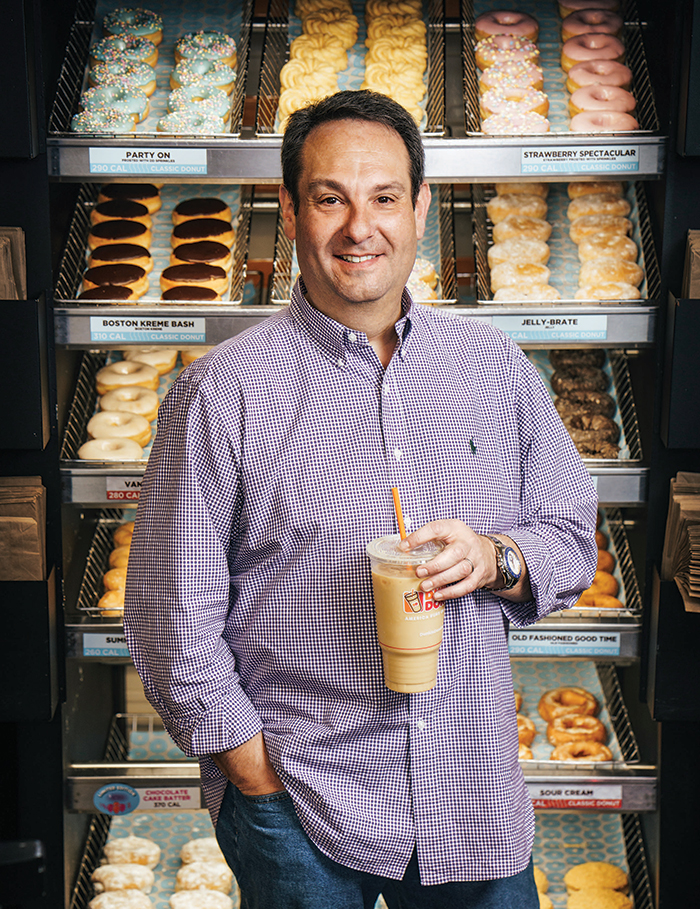
Photo: Gene Smirnov
Franchise owner Adam Goldman ’89 at his West Orange, New Jersey, store
After a significant career in corporate America, including many years as an executive consultant, Adam Goldman ’89 began exploring the possibility of owning a business. “I got tired of being on a plane from Monday through Friday,” he says. “I wasn’t finding any great manufacturing businesses for sale, but I was going to Dunkin’ Donuts every day for my coffee.” Goldman felt the store near him in West Orange, New Jersey, didn’t run as well as it should and thought he could probably do better. With his interest piqued, he began researching franchise opportunities. Dunkin’ Donuts stood out in part because it allowed franchisees some latitude in their entrepreneurial tactics. So in 2009, Goldman purchased two stores in nearby Paterson. He hired more staff, bought updated equipment, and launched new initiatives, such as delivering doughnuts to local offices.
He then purchased a third location in West Orange, but the store felt small and parking was lousy. So Goldman operated out of that Dunkin’ while building a new store just 150 yards away, this one with a drive-thru, ample parking, a kitchen, and quadruple the seating. The new location opened in December 2015. “We operated the old store until 12:30 p.m., and then opened the drive-thru at the new place at 12:31 p.m., and never skipped a beat,” Goldman says.
In an effort to control operating costs at this larger facility, he outfitted the store with green technologies, including LED lighting, high-efficiency heating and cooling, an in-house “biodigester” that breaks down food wastes to produce energy, and an electric-vehicle charging station in the parking lot. The store won Dunkin’s “Green Elite” designation, and Goldman says the West Orange community has loved the new location. “Dunkin’ told us to expect a 30 percent bump in sales due to the drive-thru,” Goldman says, “but we actually had an 85 percent bump in sales.”
Location, Location, Location
The success of Goldman’s stores (he and his wife, Karen, now own four) points in part to the importance of wisely chosen locations. Blum in Ohio prefers to locate his stores on Monday-to-Friday commuter routes, just before the driver hits the highway. “Right turn in, right turn out, you’re on your way,” he says, adding that he also considers commuter psychology. “We prefer to be at the beginning of the commute as opposed to the end. If you’re five minutes late heading out the door for your 30-minute commute, and you know we’re fast, you’ll stop for a cup of coffee even though you’re running late, thinking that you might be able to make it up,” Blum says. “But if it’s at the end of your commute, and you’re five minutes late, you’re not stopping.”
The Babson franchisees say fast but friendly service is critical, particularly at the drive-thru window. Goldman’s West Orange drive-thru serves 130 to 140 cars an hour during the morning rush. Blum coaches his teams to assume that most customers are late to work. Dunkin’ has less of a “sit-and-stay” mentality than other coffee spots, adds DiPietro, and focuses more on moving people in and out. “Our customers have to get to work, have to get the kids to school, and have to move along with their day,” he says. “Speed of service is imperative in our business.”
Competition comes from all directions. The U.S. doughnut universe includes such contenders as Krispy Kreme, Canadian chain Tim Hortons, and local bakeries. But the competition grows especially fierce around coffee and other beverages, which account for more than 60 percent of Dunkin’s U.S. sales. The competition comes from chains such as Starbucks, quick-service restaurants such as McDonald’s, local coffee shops and high-end “beaneries,” and the so-called “C” stores, or gas and convenience businesses, such as Cumberland Farms. “They’re using coffee and other beverages to drive people into their stores,” Jaspon says. “They’re actually giving the product away for very cheap, which has given us a whole new form of competition to deal with.”
Dunkin’ also competes with the coffee maker at home and at the office, Blum notes. “There are so many choices for customers to get a cup of coffee, so we have to execute at as high a level as possible,” he says. In part, this means delivering coffee just the way the customer likes it. “For every medium black coffee there are 30 people who will order it highly customized, say with one Splenda, three creams, and a pump of caramel swirl,” Blum says. “People are very particular about how they want their coffee.”
Perhaps the biggest challenge for Dunkin’ franchisees is the struggle to find good employees. Given the low national unemployment rate, employers face a severe labor shortage. A declining number of high school students—previously a reliable source of workers—apply as well, exacerbating the problem. “Applications are way, way, way down,” Blum says, “and not everyone’s cut out for customer service. I have more anxiety about staffing than any other issue. My wife will tell you: As we get closer to an opening, I get crankier and more and more anxious.” Each new location typically requires 10 to 30 employees, depending on store size and volume.
In the search for solutions, Blum and his brother have traveled to Washington to lobby on franchisee issues such as immigration reform, with the hope that increasing the number of people coming from other countries can expand the pool of available labor. Goldman notes that a large number of his employees are from Bangladesh. “I have brothers, sisters, uncles all from the same families working for me,” says Goldman, whose franchises experience unusually low staff turnover. Most employers are desperate for reliable help, Blum says. “Talk to people in other industries that support us: the carpet guy, the window guy, the landscaper, the snowplow guy. They’re all in the same boat,” he says. “Everyone’s just scratching their heads and struggling.”
We Are Family
Any time multiple franchise owners get together, staffing difficulties are a frequent conversation topic. “We share each other’s pain,” Blum says, who adds that he and other franchisees typically see one another as allies rather than competitors. Goldman says, “In general, we talk, we share ideas, we help each other out. We are more family than competitors.”
That spirit of cooperation also exists at the corporate level, where partnering with franchisees is built into the organization model. For example, Dunkin’ Brands maintains a formal committee system made up of franchisees elected by their peers. Regional Advisory Committees (RACs) elect representatives to the Brand Advisory Council (BAC), which meets with the corporate team in Canton, Massachusetts, four times a year. The BAC also has subcommittees of franchisees to focus on such areas as marketing, restaurant operations, profitability, and technology. “The meetings are useful, as you get to meet and interact with the brand leadership,” says Blum, currently co-chair of the Midwest RAC and a member of the BAC. “You don’t always get exactly what you want, but you get to share your ideas and opinions in a constructive format.”
Franchisees are central to Dunkin’ Brands, which is 100 percent franchisee-owned, notes CFO Jaspon. Dunkin’ does not run any stores itself, which contributes to a smaller-than-usual corporate structure and allows for corporate-franchisee teamwork. “Franchisees are an integral part of every decision we make,” says Anh-Dao Kefor in integrated marketing.
Corporate guides strategy, develops and rolls out new products and promotions, manages advertising budgets, and handles product nutrition information and regulatory compliance, for example, but it solicits feedback from franchisees along the way. This occurs through the committee system and in more informal ways, too. “I might pick up the phone to franchisees and say, ‘Hey, I want to run something by you,’” Kefor says, asking, for instance, about their initial reaction to a new product concept or promotion.
“People think of us as a very large corporate organization,” Jaspon says, “but it’s really a conglomerate of small business owners.” In addition to working with franchisees, Jaspon oversees the team that handles financial planning and analysis, business analytics, and tax and accounting. Her daily duties include managing interactions with the Securities and Exchange Commission and investors, and she handles the finance side of all business functions. “Every day is different,” she says. “I could be in meetings with franchisees, meetings with our investors, or leading the finance group in the office.”
In Kefor’s daily work, she views franchisees as one of the customers her integrated marketing team serves, in addition to the field teams for marketing and operations, who drive the communication and execution of upcoming programs. Kefor’s first roles with Dunkin’ were marketing positions for Baskin-Robbins, and over the next decade she eventually moved into strategic initiatives and operating systems roles, serving as the bridge between the Baskin-Robbins brand and franchisees. “I would spend my commutes every day on the phone with our franchisees, getting to know them, understanding their stores, basically building trust and credibility,” Kefor says.
At the beginning of 2018, Kefor took on her current role with Dunkin’ Donuts, leading the four-person team that oversees the 12- to 18-month marketing calendar for beverages. Her team develops monthly programs to match the season (say, Girl Scout-inspired flavors during the Scouts’ cookie season), partnering with the advertising, loyalty, public relations, and media teams to develop campaigns. Sharing the story and details of each program with franchisees keeps Kefor and her team on their toes. “We’re not developing a product and taking it straight to the consumer,” she says. “We have the opportunity to collaborate with our franchisee partners first. We want them to be advocates and ambassadors, and that requires a strong business case and due diligence on our end to get them on board. I’ve learned that you have to be proactive about franchisees’ concerns.”
Drawn in by Doughnuts
When Nisha Munshi, MBA’15, meets new people, there’s often a funny moment when they ask what she does for work. “When I explain that I’m a registered dietitian for Dunkin’ Donuts, they often look at me with a slightly confused face,” she says. Munshi earned an undergraduate degree in nutrition sciences and went on to Massachusetts General Hospital to complete a dietetic internship. She completed several clinical rotations in different areas of nutrition and discovered that she liked the broad reach she could have while working for food companies.
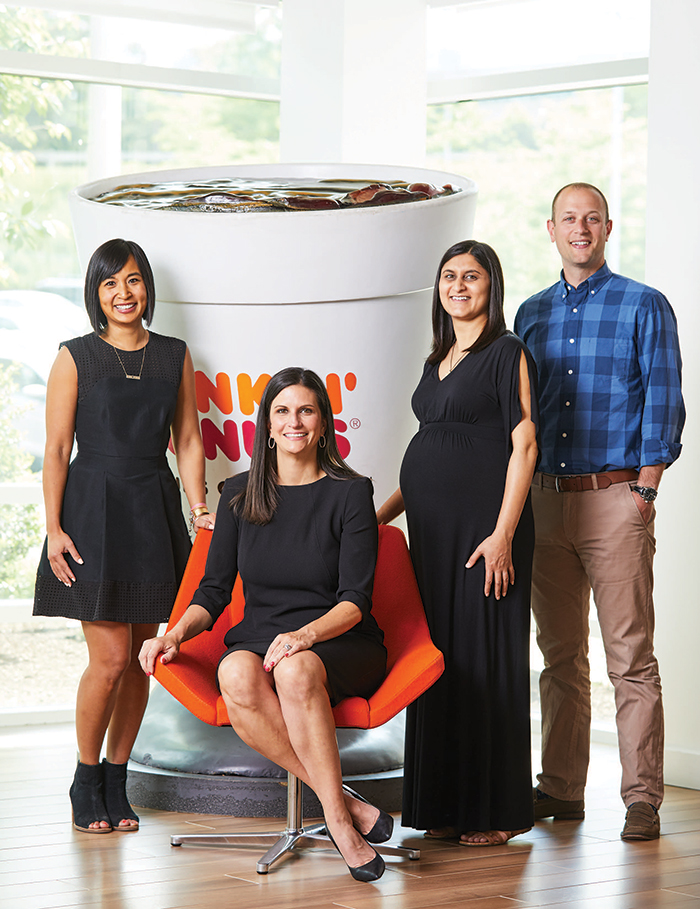
Photo: Pat Piasecki
From left, Anh-Dao Kefor ’05, Kate Jaspon ’98, Nisha Munshi, MBA’15, and Justin Unger ’08 all work in the Canton, Massachusetts, headquarters of Dunkin’ Brands.
When she began at Dunkin’, Munshi spent much of her time in a regulatory compliance role, compiling information about ingredients to create Nutrition Facts labels, as well as ingredient lists and allergen information for each Dunkin’ product. “Over the years my responsibilities have broadened to strategy, and I’m now developing nutrition-related goals and initiatives for the company as a whole,” she says.
Munshi earned her Babson MBA in part to hone her strategy skills. She also conducts trend research to track better-for-you choices at other quick-service restaurants, monitoring such information as the sugar and calorie content of their products. She shares this information with the innovation teams at Dunkin’. The company already offers options such as oatmeal and wraps with egg whites and veggies, developed in response to customer requests. “We’re always going to have those indulgent products, but consumers are becoming more savvy about what’s in their food, where it comes from, and what’s good for them,” Munshi says, adding that customers should watch for additional options coming soon. Dunkin’ Brands also removed all artificial dyes from its doughnuts and has pledged to remove them from the rest of its menu by the end of this year.
As director of strategic partnerships, Justin Unger also is responsible for reaching new customers, which his team does by linking Dunkin’ Donuts with other brands. They led a recent collaboration with Massachusetts-based shoe company Saucony, which created a Dunkin’-themed running shoe for the Boston Marathon. The shoe designers began with an existing Saucony shoe, the Kinvara 9, and tricked it out with Dunkin’ colors, images of coffee beans and a frosted doughnut, and the America Runs on Dunkin’ logo. The limited edition shoe sold out quickly, Unger says, but the benefits of such partnerships linger. “We wouldn’t necessarily be able to talk to runners the way we did, but the partnership with Saucony made our brand top of mind for new audiences,” Unger explains. “And the beauty of the partnership is that it goes both ways. We are a trusted voice for our audience, so it increases reach for both partners.”
Technology innovations also are key to maintaining and attracting customers. When Unger joined Dunkin’ Brands in 2016, he oversaw its DD Perks loyalty program and mobile app, which rewards customers with personalized promotions and offers. Customers also can use the app to place orders and pay in advance of pickup.
Dunkin’ is not alone in these types of innovations. For example, Starbucks offers a similar app. “We’ll continue to see the industry as a whole lean in on loyalty and innovation and technology and to think about how we can use them to enhance the guest experience,” Unger says. Jaspon notes a recent example of originality: “Our newest store in Quincy, Mass., is the first store in the restaurant industry that we’re aware of where you can order ahead of time, skip the drive-thru line, and go to a separate window to pick up your product.”
In the end, though, a friendly “good morning” still goes a long way in building customer loyalty, notes franchisee Goldman, who says 95 percent of the people in his stores are repeat customers. Blum agrees. “We want people to leave a little happier than when they walked in,” he says. “If we succeed, they come back the next day.”
Erin O’Donnell is a writer in Milwaukee.
]]>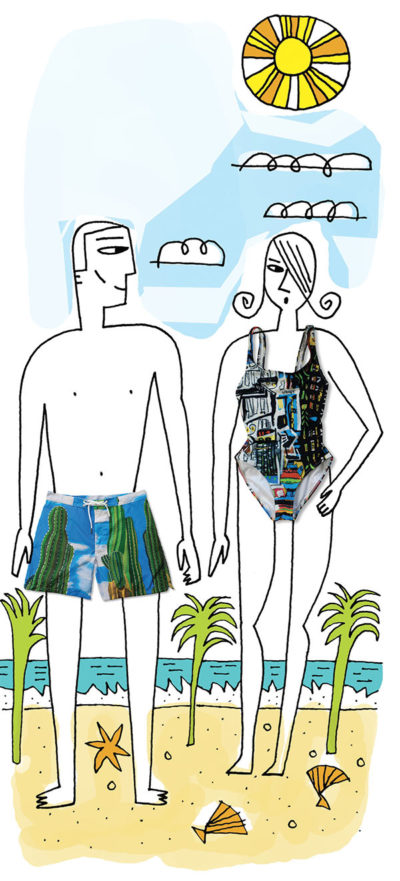
Illustration: Christian Roux
As the saying goes, art is where you find it. Thanks to John-Marshall Stubbs, MBA’14, art now can be found on one of the unlikeliest of canvases: swimwear. Stubbs selects original, colorful paintings and then adapts them for imprinting on men’s and women’s swimsuits, which he sells through his company, Curated Clothing.
Growing up in Dallas, Stubbs was immersed in art—and commerce—from a young age. His mother owned a gallery, and he spent his early years visiting galleries and art fairs. After college, where he majored in art history and minored in business, he ran a second outlet of his mother’s gallery.
But the entrepreneurship bug also bit him early, so he soon came to Babson for his MBA. Shortly after graduating, Stubbs came across a process called sublimation printing, which makes it possible to reproduce high-resolution images on polyester fabric. Inspired, he pondered the potential of various printed products before having a eureka moment: “At three in the morning, I shot out of bed and wrote down ‘swimsuits,’ so I wouldn’t forget it.” That was in July 2014; he set to work researching manufacturers and had his first sample suit ready that December.
Today, Curated Clothing sells numerous styles online and in several retail stores. The business has changed the way Stubbs looks at paintings. “Now, when I see a piece of art,” he says, “I think in terms of how I can cut it up and put it on a swimsuit.” Stubbs also has become skilled at manipulating images in Photoshop to make them swimsuit-ready.
His cred as a former gallerist makes artists comfortable working with him, says Stubbs. Each suit is labeled with the artist’s name and signed, and Stubbs, who works with about 16 artists, takes his mission seriously. “I’m not just buying an image,” he says. “It’s an art gallery you wear.”
Now living in Los Angeles, Stubbs wears his own creations frequently. “I go to the beach a couple of times a week,” he says, “and every time, someone says, ‘That’s a cool swimsuit.’”
]]>
Photo: Andrew Klein
Artwork: LaShonda Cooks ’10
The daughter of an art teacher, Cooks says she was “always interested in the arts.” But even in high school, she recognized the value of a business background for an aspiring artist, and after a Babson brochure found its way into her hands, she thought the College might be the right place for her. An Enrico Dallas Scholarship—a four-year award for Dallas-area students— sealed the deal.
At Babson, Cooks was active in theater and on the student newspaper but always enjoyed the refuge of the ceramics studio. “Back then, very few students would venture there,” she says, “but for me it was therapeutic and peaceful.”
She turned to painting after Babson. Now, when she finishes her day job as an insurance adjuster for Geico, Cooks can be found in her studio for two hours every Monday, Wednesday, and Friday (“just to structure it a little bit”). She also leads free paint parties at a local recreation center. “That’s my way of giving back,” she says.
Much of her work is done on commission. Clients typically provide photos of loved ones, and Cooks brings her distinctive style to each portrait. “I try to capture their essence,” she says. But her own artwork ranges much more freely. “I like to paint what inspires me,” she says. “Dancers, movement, couples, a ballerina. Women that are strong and powerful. Women of color.” Questions about female identity intrigue her, as she grapples with societal notions of “what a woman is, and what a woman isn’t.”
However substantive her themes, Cooks’ work remains ebullient. “I like to capture a range of emotions,” she says, “but typically, they’re happier emotions. My paintings are pretty serene and joyous.”
Cooks and classmate Jamaal Eversley ’10 will hold a joint art exhibition on campus in the Hollister Gallery. The show opens on Back to Babson weekend, starting September 15.
]]>Artists have been carving gourds for at least 4,000 years in Peru; McLaughlin began carving 11 years ago in Minneapolis, her home for many years. An avid gardener, she planted some gourd seeds alongside a winding path at the back of her property. Thenceforth the trail, overhung with gourd vines hanging from trees, was known as Gourd Alley, and the bountiful harvest inspired McLaughlin to start carving. The name stuck: McLaughlin, now a professional gourd artist who splits her time between Florida’s Sanibel Island and Sandwich, Massachusetts, calls her business GourdAlley.
McLaughlin describes the medium as similar to soft wood, and her creations fall into roughly two categories. Larger specimens are crafted into bowls or ornamental containers. Miniature gourds become “gourdikins”: rotund little people, whimsically painted and accessorized, that are suggested by the gourds’ bulbous shapes.
The creative impulse came naturally to McLaughlin. Torn between art and business as a teen, she originally enrolled at Skidmore College but transferred to Babson. Focusing her studies on business suited McLaughlin. But, she adds, “I have a creative side that can’t be repressed.”
McLaughlin also has a strong stomach, which comes in handy for carving gourds. She places her fresh gourds in storage for a year to dry; when they emerge, they are moldy and malodorous. A dried gourd must then be bleached and scrubbed cleaned—“to within an inch of its life,” says McLaughlin—before it can be carved. “Carving gourds is not for sissies,” she notes. “You must wear a mask, and you must love power tools.”
Carving gourds went from avocation to vocation for McLaughlin when she “retired somewhat” a few years back. She has sold her work at craft shows but is now happy to be part of a nearby artists’ retail co-op.
The irrepressibly creative McLaughlin also paints furniture, but gourds are her passion. “I have a lot of variety in my work,” she says. “It’s not just a flat canvas. It’s three-dimensional, and it’s based in nature. The wonderful thing about working in gourds is that you can carve them, you can cut them, you can stain them. I’m not locked into anything. That’s what makes it fun.”
]]>
Photo: Tom Kates
Drishti Chhabria ’17 (left) and Siddhi Mehta ’17
For one night each fall and spring, the Sorenson Center for the Arts fills with song and dance, color and splendor. Aman, the long-standing South Asian student organization, puts on a show to celebrate the cultures of India, Pakistan, Nepal, Bangladesh, and Sri Lanka. The evening features a fashion show, a live band, and a play in the style of a Bollywood movie. A dinner for cast, crew, and audience members concludes the night.
“You get to experience the foods, the music, the clothes, everything,” says Drishti Chhabria ’17, president of Aman, which boasts some 150 members, making it one of the largest student organizations on campus. “The shows are fabulous,” says Cheryl Kirschner, senior lecturer in law, who has been attending Aman’s performances for years, even before she took over as the group’s faculty advisor in 2006. “I am proud to say that students conceptualize, plan, design, choreograph, and rehearse the entire show themselves.”
That takes work. In the week before the show, Sorenson becomes abuzz with activity. Students are working on props, rehearsing dances, and hashing out the million little details that go into a smooth performance. Practices stretch till the early morning. “It takes a lot of time,” says Siddhi Mehta ’17, Aman’s vice president. “We’re living in Sorenson.”
Beyond its shows, Aman is involved in a number of other campus activities. Members help put on the Babson India Symposium, a business and entrepreneurship conference; hold a dinner and prayer service for Diwali, the Hindu festival of lights; and organize a celebration for Holi, a Hindu welcoming of spring. Through its events, Aman hopes to share its members’ cultures with the larger Babson community. “We want people to become more familiar with who we are,” Chhabria says. “It gives me ample happiness to bring a part of my culture to the stage with Aman.”—John Crawford
]]>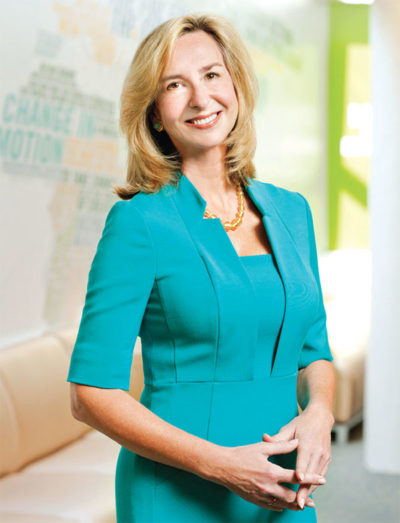
Photo: Webb Chappell
Babson President Kerry Healy
Forbes recently ranked Babson No. 1 on its inaugural list of the “50 Best U.S. Colleges for International Students 2016.” This incredible achievement and honor affirms what Babson has always known: Our global community is among our greatest strengths.
The goal of this first-of-its-kind list, as described by Forbes, is to help guide the decision making of foreign students and their families as they consider education in the United States. Since 2014, Babson has seen international applications increase by more than 50 percent. We are proud to foster a welcoming and inclusive campus environment where students of all nationalities live and learn together and develop a truly global entrepreneurial mindset.
Babson’s Class of 2020 is the most diverse—domestically and internationally—in College history. Twenty-nine percent of first-year students are international, and an additional 10 percent of U.S. students have dual citizenship, which means nearly 40 percent of students have a non-U.S. passport. This multitude of cultures, perspectives, experiences, and backgrounds enhances our campus community and contributes to the innovative and transformative experience that is a hallmark of Babson. We are educating global citizens equipped to tackle the world’s most pressing problems and create great social and economic value everywhere.
Just as students from around the world arrive at Babson every fall, we continue to bring Babson to the world. Babson offers more than 100 study-abroad programs in 40 countries, and nearly half of all undergraduates choose to immerse themselves in another culture by living and learning abroad. Our global engagement extends to high-profile entrepreneurial ecosystem projects, research, and key partnerships worldwide, and our new edX program provides anyone, anywhere, with free online access to select Babson coursework on entrepreneurship.
This March, alumni, faculty, staff, parents, and friends will travel to Bangkok for the third annual Babson Connect: Worldwide, our premier global entrepreneurship summit. Babson Connect: Worldwide is an opportunity for our community and global business leaders to exchange ideas and insights about how we can build a better world through innovation, entrepreneurship, and family enterprise. Following the success of our two summits in Cartagena, Colombia, and Dubai, United Arab Emirates, we anticipate a wonderful event for entrepreneurial leaders and business families to connect with and inspire one another.
We also are exploring ways to expand our reach by establishing small-footprint, high-impact Hubs in global gateway cities. Each Babson Hub will have a site-specific selection of our programming, including offerings from the graduate school, executive education, and accelerator programs, such as Babson’s award-winning Women Innovating Now (WIN) Lab. Babson Hubs already have proven successful in Boston, San Francisco, and Miami, and we see incredible potential to establish additional Hubs in key locations around the world.
These are just a few examples of the many ways that Babson supports and celebrates our global community. Babson takes great pride in our global network of 40,000 alumni and friends in 114 countries. Fostering and expanding this community is central to our mission of educating entrepreneurs of all kinds and to our vision of making Entrepreneurial Thought & Action accessible to everyone on the planet.
]]>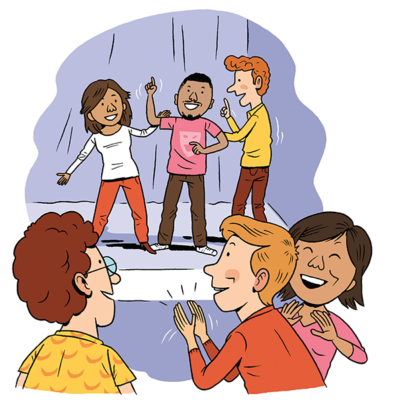
Illustration: Scott Garrett
“This is about people who want to come together and be goofy,” says Kai Haskins ’18. Frankly, he believes some goofiness is needed. “People are so focused. They take everything so seriously,” Haskins says. “I think it’s important to take a moment and be foolish.”
A group of friends formed the ensemble, its name a nod to Roger Babson’s obsession with gravity, in spring 2016. Since then, they have performed regular shows at Roger’s Pub & Grille. “We’re going to hang out and be funny no matter what,” says Katherine Will ’18. “We might as well entertain people at the same time.”
Catch one of the group’s shows, and you’ll see comedy created and performed in the moment without the aid of a script. As audience members shout out suggestions, the improvisers may pretend to be Dating Game contestants, or perform a fake movie, or run through a skit called Weekend at Bernie’s, in which cast members die off one by one, until only one person is left to portray all the roles.
These out-on-a-limb performances take courage. Mistakes are routine. “All of us have made jokes that don’t land,” Haskins says. “You have to power through it. If you mess up, just wait 45 seconds for someone else to mess up.” A favorite quote of Max Mendelsohn ’18 is playwright Samuel Beckett’s famous ode to failure: “Ever tried. Ever failed. No matter. Try again. Fail again. Fail better.” It makes a fitting battle cry for improvisation.
For Mendelsohn, improv serves as a crucial break in his day-to-day routine. “It’s a stress reliever,” he says. “I need the escape.” When done right, improv forces performers to be present. There is no time for doubt, discussion, or hesitation on stage. If performers have an idea during a scene, they shouldn’t mull it over. “Just throw it out there,” Mendelsohn says. “Don’t think about it.”
Students Against Gravity is sponsored by The Empty Space Theater, a Babson theater group, and its faculty advisor is Sandra Graham, associate professor of ethnomusicology. Graham hopes the dozen or so student improvisers in the troupe will continue to develop as performers. This semester, Larry Coen, a Boston improv comedian and actor, will run the group’s rehearsals. “I would like to see Students Against Gravity grow into a troupe of performers who know and trust each other completely, so that they take ever greater risks,” says Graham.
While performing improv has the added bonus of sharpening many critical business skills, such as adaptability, communications, and creativity, students find great joy in one skill in particular: making people laugh. To face a room full of strangers, who are staring at you and waiting in anticipation, and make them burst into laughter is an amazing experience. “It’s a top-of-the-world feeling,” Mendelsohn says.—JC
]]>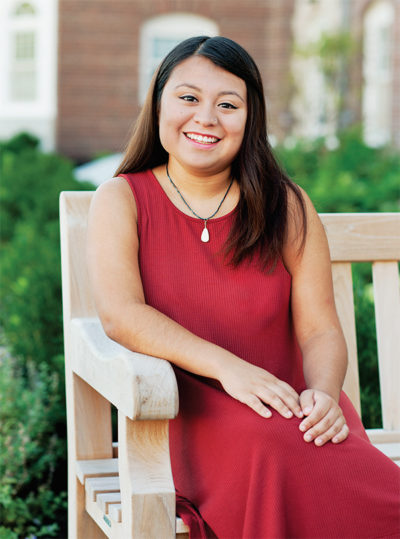
Photo: Webb Chappell
Tiffany Tapia ’17
Tapia, the oldest of three daughters whose parents emigrated from Mexico, always knew that college would somehow be in her future because her mother continually stressed the importance of an education. “My mom wanted to go to college, but she didn’t have the financial means,” Tapia says. “She tells us that it’s a privilege, and that if we want to do well in life, get a good job, and be able to travel, we need an education.”
With hard work and help from a dedicated high school guidance counselor, Tapia found her way to Babson. Coming from a small, close-knit high school, Tapia was initially nervous. “I had no idea what to expect, and no one to turn to for advice,” she says.
Her first year, Tapia struggled to keep up with the fast pace of classes and doubted her ability to succeed. Then in 2014, Academic Services reached out to first-generation students to create the FirstGen@Babson group. Coming off a difficult semester, Tapia was excited to connect with students who had similar stories. The group provided academic support and advice, such as studying tips and how to prioritize time and save money on textbooks.
Although Tapia enjoyed the experience, she longed for a group that was more personal and addressed the concerns that first-generation students often face inside and outside the classroom. “You can’t tell by looking at someone’s appearance if they’re a first-generation student and what their needs are,” she says. Many struggle with issues such as pressure to support their families financially, feeling bad about leaving their families, and feeling compelled to take full advantage of the myriad opportunities available at college. They also can feel lost and lack the necessary support and guidance to tackle these problems on their own. Says Tapia, “I wanted to give them a voice and lead them to the resources they need to succeed.”
In response, she founded the Babson FirstGen Club. Now serving in her second year as president, Tapia notes that the club has about 80 members, holds at least one event each month, and is open to all students, both first-gen and allies. “First generation can mean a lot of different things,” says Tapia. “It can mean a student who is the first in their family to go to college, a student who is the first in their family to go to college in the U.S., or a student whose parents started college but didn’t finish. This club provides a safe space for all students to build support, networks, and friendships.”
Tapia hopes to build upon last year’s work of creating awareness for the club while expanding into new areas, such as identifying and engaging with first-generation alumni, faculty, and staff. She hopes to bring these individuals to campus to speak at meetings, and for them to become mentors for students as they navigate their college and post-college careers. “The first-generation experience is so unique,” she says. “I know we would all benefit from being able to talk with individuals who were able to succeed.”—Alexa D’Agostino
]]>